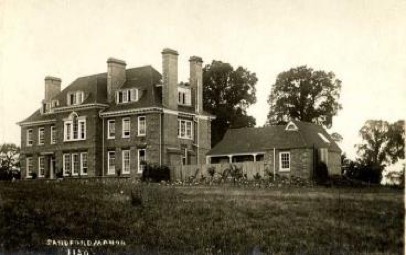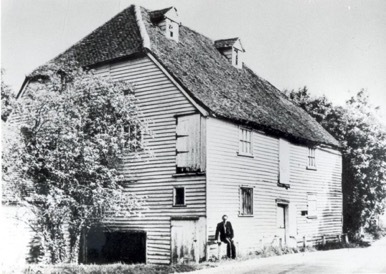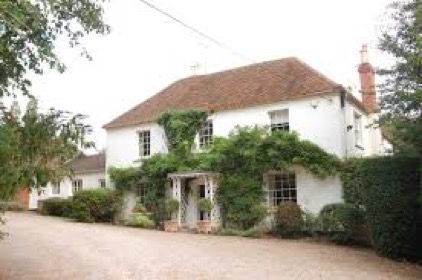Sandford Manor

Sandford Manor was built in 1911 on 12 acres of land bought by Herbert and Helen Godsal for £525. The vendor was the South Berks Syndicate which had recently bought part of the Holme Park estate.
The architect of the house was Arthur Cox of the firm Millar and Cox who were based in Reading. The house was completed by 1913.
Mr and Mrs Godsal were a wealthy couple who also had a house near Belgrave Square in London. He was a barrister and inventor. One of his patented inventions was the design for Improvements in Steering Torpedoes or other Moveable Objects (1897).
Herbert Godsal served during WW1, as a Captain, in the Hampshire Yeomanry (Royal Hampshire Carabiniers). The Reading Mercury newspaper21/11/1914 includes his name under Woodley Parish in the Roll of Honour, Men Serving in HM Forces.
Helen Godsal sold Sandford Manor in October 1919, to Catherine Watson, the wife of Arthur Watson, of 13 Savile Row, London, for the sum of £7,000.
A substantial building, particulars of which appeared in an auction catalogue of 1919, described as follows:
“Sale of imposing modern Georgian residence.
Manor house, stabling, pair of picturesque modern cottages (1911), 12 acres of well-timbered meadow-land with frontage to river Loddon”.
At that time the house had a long carriage drive and 14 bed and dressing rooms. The grounds comprised tennis and croquet lawn, kitchen garden and meadow land.
Outgoings: Sandford and Woodley tithe £3/11/0
Vicarial corn rent: 13s 6d
The house came up for sale again in 1926. The estate catalogue described the property as “A charming replica of an early Georgian manor house. Electric light from a private plant; central heating with radiators in nearly every room; water supply from a deep artesian well; heated garage”.
Kelly’s Berkshire directory for 1915 lists one Herbert Godsal living in the manor house, in 1920 a Mrs Watson was living there and in 1928 J L Brooks, all listed as private residents. It appears to have changed owners fairly frequently.
The manor house is still approached down a private residential drive just north of Sandford Mill. It is now described on an estate agent’s website as an eight bedroomed semi-detached house, estimated value £3.5 m. There is also a video production company occupying part of the building. The exterior does not appear to have changed since it was built in c. 1910.
So far, no evidence has been found to suggest that the house was built on or near the site of an earlier building.
Sandford Mill

Sandford Mill is in the liberty of Woodley and Sandford, which consisted of part of the manor of Sonning in the north, along with some smaller manors in the east and west. Pevsner (1966) describes the buildings as “A very pretty group of white weatherboarded mill and separate miller’s house in the trees”. It appears in Rocque’s 1761 map of Berkshire. In 18C maps Sandford Lane was known as Mill Lane. On Norden’s map of 1609 the mill is shown as being next to the Emm Brook but is now on the river Loddon – probably an inaccuracy from when the map was drawn up.
The Loddon lily grows in abundance in the grounds of the mill, which together with Lodge Wood is a designated SSSI and contains 10% of the UK population of the lily.
History
A mill was recorded in the Domesday survey of 1086 and was quite likely one of the two mills counted in Sonning.
The mill has certainly had a chequered history. In 1557 Sir Edmund Pecham transferred his interest in a lease on the mill for 80 years granted by the Bishop of Salisbury to one Richard Ward.
In the 1640s the mill was sacked for supplying corn to the Royalists and in 1645, during the Civil War, the bridge by the mill was pulled down. The miller was “…on pain of death, to suffer none to passe that way to Okingham” and Ralph Norton wrote, “They have pulled up the Twyford bridge and burnt mills at Twyford and Sandford and will not suffer any man to pass that way to London”.
One hundred years later the mill was burnt down for a second time – the Reading Mercury of 1 February 1768 reports that Richard Hutchinson of Sonning was accused of burning down his mill (Sanford Mill). The issue of 11 December 1769 records that John Sharp of Sanford Mill Sonning died.
In 1771/2 the mill was rebuilt with two internal water wheels and on the bridge next to the mill the keystone bears this date.
Sandford Mill has variously been referred to as ‘Woodley Mill’, ‘Hurst Mill’ and ‘Sonning Mill. Angela Walker, in the ‘River Corridor Survey 2010’ writes that ‘North of Loddon Bridge the river Loddon splits into two streams, the river Loddon and Old Loddon’. Both have followed these routes since 1873. There is also the Copperbridge Stream which leaves the Loddon and then rejoins it again before reaching Sandford Mill.

From 1802 to 1837 John May was miller (May family history). Mrs Jane May is recorded as miller in 1847, 1864, 1869 and 1877.
The following notice appeared in the Reading Mercury of 21 May 1864, ‘Persons are Cautioned NOT TO FISH that part of the river Loddon, extending from Sandford Mill, Hurst to Twyford Mill, the property of John Leveson GOWER Esq’. Trespassers will be prosecuted.
In the Reading Mercury of 8 October 1864, the following advertisement was placed, ‘Miller wanted, a single man. A Journeyman miller used to grist work. Apply personally to Sandford Mill, Sonning, near Reading’.
In 1866 William Pope, a miller in the service of Mrs Jane May of Sandford Mill in the parish of Sonning was brought up in the custody of Superintendent Millard charged with felonious reasons.
In 1874 Master millers were needed at the mill.
It is recorded that gleaners around Hurst would take their gleanings to Sandford Mill to be ground into flour and then would take their dough to the baker for baking into loaves.
The Reading Mercury of July 1892 reported that the bridge at Sandford Mill, which was a private road and had been a toll road, was about to be dedicated to the public. Sandford Mill was in 1919 part of the Winnersh portion of the Haines Hill Estate (Hurst), then owned by Captain William Godsal, Herbert Godsal’s elder half brother. The Winnersh portion of the Haines Hill Estate was sold in 1919/20.
During the Second World War Italian PoWs were put to work dredging the river Loddon around Sandford Mill and German PoWs helped a diver who was repairing the structure at the front of the mill.
In Kelly’s Reading Directory of 1954 the Over brothers were listed at the mill. Milling ceased in the late 1950s because serious erosion of the river banks was thought to be too costly to repair. The channels to the water wheels were filled in.
Kelly’s Berks, Bucks and Oxon directories give the following persons living at the mill:
1847 described as ‘gentry’ Daniel May esq.
1854 Mr May miller
1883 William Medcalfe miller and farmer
William Medcalfe appears in every directory up to and including that of 1907.
1911 Herbert George Toombs ‘private resident’
1915 ACC Kenyon-Fuller ‘private resident’
1920 Mrs Hayes ‘private resident’
1928 major John Travel ‘private resident’
Census records
1841
Head Daniel May, mealman Sonning
Ellen 61
Thomas 30
Catherine 15
1851
Head Jane May, miller and farmer
There were seven other people in the household, consisting of five sons and daughters including William aged 20, John May, 70, a visitor, and Anthony May, 25, servant miller.
1861
Head Jane May, widow, 57, miller and farmer of 80 acres
Emma 26, agricultural labourer
Anthony 34, miller
And four other workers including 2 carters and a house servant
1871
Head Jane May widow, 67, farmer and miller
Living with Jane at this time were two granddaughters, a cousin aged 80 and a widowed sister aged 53.
1881
William Medcalf head, 46, farmer, born Burghfield
Emma, 46, born Sandford Mill
William, 19, farmer
Emily, 17
Mary Ann, 13
James Foscott, 31, servant
1891
William Medcalfe head, widower 56, born Burghfield, farmer and miller
Living with William are two grandchildren including Lionel May aged 2, one boarder, one servant and two lodgers described as farm servants
1901
William Medcalf head, 65, employer
Elizabeth his wife, 36 born in Somerset (he had clearly remarried)
Dorothy, daughter aged 1
Lionel May, grandson aged 12, born Stoke Newington
Jacob Pearce, boarder, aged 33, shepherd, born Marlborough
1911
Head, Jane Terrett, 57, widow, private means
Daisy Hazell, 17, general servant domestic.
Also found, the family tree of William May, born 1830, Sandford, miller and farmer of Sandford Mill and Coleman’s Moor farm, d. 1924 at Lower Caversham. This appears to be the same William, son of Jane May in the 1851 census, then aged 20.
Author – I would like to thank the staff at the Mills Archive, Watlington House for their assistance and in particular to Mr Tom Hine who generously gave me a copy of his notes.
